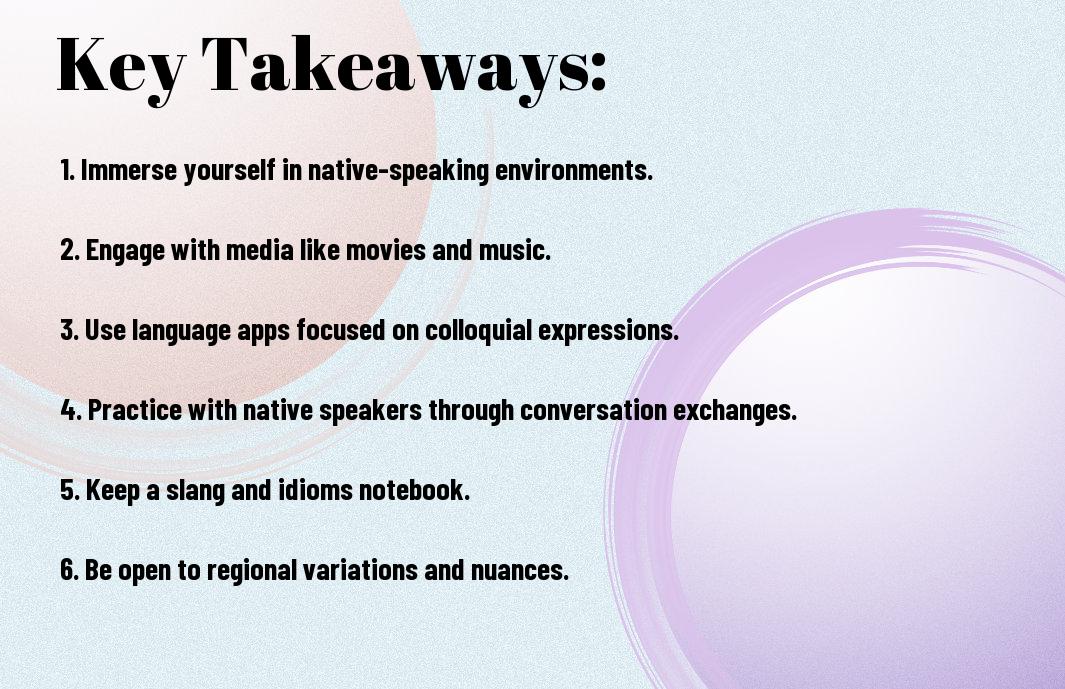As you research into a new language, you’ll soon discover that mastering slang and idioms is key to sounding like a native speaker. You’ll want to learn these expressions to improve your communication skills and connect with others on a deeper level. Your language learning journey will become more effective as you explore the world of colloquialisms, and with the right approach, you can effortlessly incorporate them into your everyday conversations, making your speech more natural and engaging.
Key Takeaways:
To effectively learn slang and idioms in any language, consider the following points:
- Start by immersion in the language, surround yourself with native speakers, and engage in conversations to pick up colloquialisms and expressions naturally.
- Familiarize yourself with online resources, such as language learning apps, blogs, and videos, that provide explanations and examples of idiomatic expressions and slang terms.
- Practice actively by using slang and idioms in your own speaking and writing, which will help you to internalize the language and sound more authentic.
- Focus on contextual learning, understanding the nuances and connotations of idioms and slang, and how they are used in different situations and cultures.
- Develop a habit of reviewing and revising vocabulary, including slang and idioms, to reinforce your learning and consolidate your knowledge over time.
Getting Started
Before you begin your journey to learn slang and idioms, it’s imperative to understand the basics of the language. You can start by checking out resources like Mastering American Slang: A Guide for F-1 Students to get an idea of what to expect.
Identifying Slang and Idioms in Context
The key to learning slang and idioms is to identify them in context. You will encounter various phrases and expressions that may seem unfamiliar, but as you listen to or read native speakers, you’ll start to pick up on their meanings.
Building a Foundation with Basic Phrases
Along with learning grammar and vocabulary, you should focus on building a foundation with basic phrases that are commonly used in everyday conversations. You will find that many slang expressions and idioms are derived from these basic phrases.
Considering your goal of mastering slang and idioms, it’s vital to practice using basic phrases in context, which will help you to better understand how native speakers use them in different situations, allowing you to develop your skills more efficiently and effectively, and enabling you to communicate more confidently and naturally in your target language.


Language Immersion
Even if you’re not in a country where your target language is spoken, you can still create an immersive environment to learn slang and idioms, by listening to music, watching TV shows and movies, and speaking with native speakers online.
Surrounding Yourself with Native Speakers
Along with practicing your language skills, you’ll pick up slang and idioms by interacting with native speakers, which will help you learn the nuances of the language and get a feel for how it’s used in everyday conversations.
Engaging with Local Media and Culture
Additionally, as you explore local media and culture, you’ll be exposed to a wide range of slang and idioms that are commonly used by native speakers, helping you to better understand the language and its contexts.
Immersion in local media and culture will also give you insight into the history and evolution of slang and idioms, allowing you to understand their meanings and usage, and incorporate them into your own language practice, making you sound more natural and fluent in your target language.
Learning Resources
Your ability to learn slang and idioms in any language depends on the resources you use. You can find a variety of tools online to help you improve your language skills.
Language Learning Apps and Websites
Along with traditional language learning methods, you can utilize online platforms that offer interactive lessons and exercises to learn slang and idioms. You can explore different apps and websites to find the ones that suit your learning style.
Dictionaries and Thesauruses for Slang and Idioms
Around the topic of slang and idioms, you will find specialized dictionaries and thesauruses that can help you understand the meanings and usage of different expressions. You can use these resources to learn new phrases and expand your vocabulary.
Plus, many dictionaries and thesauruses for slang and idioms provide example sentences and contextual information, which can help you understand how to use the expressions in everyday conversations. You can access these resources online or purchase them as books, and they will be a valuable addition to your language learning toolkit.
Practice and Reinforcement
Many language learners find that consistent practice helps solidify slang and idioms in their long-term memory, making them easier to recall in conversation. You will see significant improvement as you continue to practice and reinforce your learning.
Conversational Practice with Native Speakers
Against all doubts, conversing with native speakers is an excellent way to learn and practice slang and idioms in context, allowing you to get a feel for how they are used in everyday conversation.
Using Flashcards and Quiz Games
Practically, using flashcards and quiz games can be an effective way to memorize slang and idioms, making the learning process more engaging and fun for you.
To take your learning to the next level, you can create digital flashcards with the slang or idiom on one side and the definition or example sentence on the other, and use quiz games to test your knowledge and identify areas where you need more practice, helping you to stay motivated and track your progress over time.
Overcoming Challenges
For language learners, mastering slang and idioms can be a daunting task, but with persistence and the right approach, you can overcome the obstacles and become proficient in using them in your everyday conversations.
Dealing with Unfamiliar Expressions and Nuances
Besides the difficulty of understanding the meanings of slang and idioms, you will also encounter nuances that can change the connotation of a phrase, making it crucial to learn the context in which they are used.
Avoiding Common Mistakes and Misconceptions
Between the lines of language learning, you will find that avoiding common mistakes is key to improving your skills, and being aware of the misconceptions that can lead to misunderstandings will help you to use slang and idioms correctly.
Plus, as you research deeper into the world of slang and idioms, you will find that avoiding literal translations and instead focusing on the idiomatic expressions will help you to sound more natural and fluent in your conversations, allowing you to convey your intended message more effectively and connect with native speakers on a deeper level.
Advanced Techniques
Now that you have a solid foundation, you can explore advanced techniques to learn slang and idioms. Consider the following:
- Immersive learning
- Contextual practice
| Technique | Benefits |
|---|---|
| Immersive learning | Improved comprehension |
| Contextual practice | Enhanced fluency |
Idiomatic Expressions in Different Contexts
Idiomatically, you will find that expressions vary across contexts, and you need to understand these differences to use them effectively in your language learning journey.
Using Slang and Idioms in Creative Writing
An adept writer, you can leverage slang and idioms to add flavor to your writing, making it more engaging and authentic.
Idioms can be a powerful tool in your creative writing, allowing you to convey complex ideas and emotions in a unique and captivating way, and as you master them, you will be able to craft compelling stories that resonate with your audience, and you will find that your writing becomes more expressive and nuanced, reflecting your growing proficiency in the language.
Final Words
To wrap up, you’ve now got the tools to learn slang and idioms in any language. You can enhance your skills by practicing regularly and immersing yourself in your target language. For more information, visit Talking the Talk: Slang and Idioms Help You Sound Authentic to improve your understanding of nuances and sound more natural in your conversations.
FAQ
Q: What is the most effective way to learn slang and idioms in a new language?
A: To learn slang and idioms in a new language, it’s important to immerse yourself in the language as much as possible. Listen to music, watch TV shows and movies, and try to engage in conversations with native speakers. Pay attention to the context in which certain phrases are used and try to understand the underlying meaning. You can also use online resources such as language learning apps, blogs, and social media to learn new slang and idioms. Additionally, try to learn a few phrases at a time and practice using them in your own conversations to help you memorize them more effectively.
Q: How can I improve my understanding of slang and idioms in a language when I’m not surrounded by native speakers?
A: If you don’t have the opportunity to interact with native speakers on a daily basis, there are still many ways to improve your understanding of slang and idioms. You can start by reading books, articles, and blogs written in the target language, which can provide valuable exposure to different types of language and vocabulary. You can also use online language learning platforms, such as podcasts, YouTube channels, and language exchange websites, to learn from native speakers and practice your language skills. Furthermore, try to find language exchange partners or online communities where you can engage in conversations and ask questions about slang and idioms you don’t understand.
Q: Are there any specific tips or strategies for learning slang and idioms that are particularly difficult or nuanced?
A: Yes, there are several tips and strategies that can help you learn difficult or nuanced slang and idioms. One approach is to focus on learning phrases in context, rather than just memorizing individual words or phrases. Try to understand the cultural and historical background of the slang or idiom, as well as the emotions and attitudes it conveys. You can also use visual aids such as diagrams, infographics, or videos to help you understand complex phrases or expressions. Additionally, practice active listening and try to repeat what you’ve heard to ensure you understand the pronunciation and intonation correctly. Finally, don’t be afraid to ask for clarification or explanation if you’re unsure about the meaning of a particular phrase or expression.



